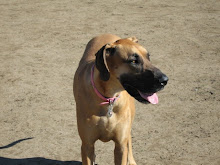Imagine you just finished grilling a beautiful filet mignon steak. You realize that you forgot the steak sauce, so you walk away from the table to go to the refrigerator and get it. Out of the corner of your eye, you see your dog staring at the steak, walking straight toward it while salivating as if you’d served it to him in his dog bowl!When do you think is a good time to correct your dog by telling him “no” and putting him into a down/stay position? While he’s definitely thinking of stealing the meat? Or not until after he’s already taken it and run off with it in his drooly mouth?In the above scenario, it seems obvious that it would be best to stop your dog before he actually takes the steak. One of the reasons I love to use this example is because of its obvious simplicity.However, similar timing is also applicable to many other situations. It is always best to redirect your dog into a more appropriate behavior before he gets to the full extent of the bad behavior, as long as you’re certain he’s thinking of doing it.To clarify, another example would be a dog who barks and pulls when he sees other dogs. If you’re walking your dog and he sees another dog, assumes a “stalking” posture and is staring at the approaching dog, it is certain that if you don’t correct him, he will escalate into the full-fledged barking/pulling behavior. Instead, you can tell your dog “no” and get his attention back on you as soon as the staring begins.There are a multitude of other scenarios to which this applies… you just have to use your imagination. Is your dog definitely planning on jumping on the visitors? Probably yes, if he’s all excited, hopping around and acting like a madman while they’re walking up your path. Is he definitely going to rifle through the trash? Probably yes, if he’s sniffing the garbage can, licking its edges and has done this before. No need to wait until he’s already strewn the coffee grinds, banana peels and raw chicken wrappers all over the kitchen.Redirecting your dog as soon as the thoughts or feelings are occurring to him can be an excellent way to solve behavioral issues. By not waiting until your dog is fully in the throes of barking, or until after he’s received the “reward” of licking the chicken wrappers, behaviors can be redirected much more quickly and effectively.Beware that it is very important to be careful that you are reading your dog’s body language correctly. For example, if you have a puppy who is circling around on the living room carpet, it’s possible that he is getting ready to have an accident. However, dogs also circle around when they’re simply getting ready to lay down and you wouldn’t want to correct him for that. Get to know your pet and be sure you’re reading him correctly before moving forward with your educational exercises.With a little effort, you can read your dog’s body language and head off problems before they escalate, resulting in a more well-behaved pet, fewer incidents along the way and problems solved much more quickly.
Article written by Lori VerniLori Verni is a freelance writer, Certified Master Trainer and owner of Best Paw Forward Dog Education in Holly Springs, NC. She also proudly brings you all of the free articles on FreeDogTrainingInfo.com, and has a book available: Everything You Need to Know About House Training Puppies & Adult Dogs. The book can be purchased at www.FreeDogTrainingInfo.com
Keywords: dog toys, dog beds, dog collars, pet supplies, dog training, dog health
Subscribe to:
Post Comments (Atom)






No comments:
Post a Comment